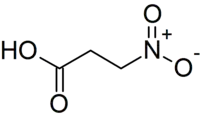 | |
| Names | |
|---|---|
| Preferred IUPAC name
3-Nitropropanoic acid | |
| Other names
3-Nitropropionic acid; β-Nitropropanoic acid; BPA; 3-NPA | |
| Identifiers | |
3D model (JSmol) |
|
| ChemSpider | |
| ECHA InfoCard | 100.007.276 |
PubChem CID |
|
| UNII | |
CompTox Dashboard (EPA) |
|
| |
| |
| Properties | |
| C3H5NO4 | |
| Molar mass | 119.076 g·mol−1 |
| Melting point | 65–67 °C (149–153 °F; 338–340 K) |
Except where otherwise noted, data are given for materials in their standard state (at 25 °C [77 °F], 100 kPa).
Infobox references | |
β-Nitropropionic acid (3-nitropropanoic acid, BPA, 3-NPA) is a mycotoxin, a potent mitochondrial inhibitor,[1] which is toxic to humans. It is produced by a number of fungi, and may be found widely in food such as in sugar cane as well as Japanese fungally fermented staples, including miso, soy sauce, katsuobushi,[2] coconuts[3] and some traditional Chinese medicines.[4]
It can be caused by extreme weather, stressed crop growth conditions, as well as storage conditions (like moisture),[5] which can give a further rise under global warming conditions.[6] Fungi of the genus Arthrinium are known to produce 3-nitropropanoic acid.[7]
It is found that 3-nitropropionic acid is a mitochondrial toxin and produces striatal alterations in rats similar to those observed in the brain of Huntington’s disease patients, and administration of the cannabinoid receptor agonist WIN55212-2 to rats for six consecutive days, before the 3-NPA injection, exerted preventive effects on all alterations elicited by the toxin, like mitochondrial dysfunction and lipid peroxidation, by activation of the CB1 receptor.[8]
References
- ↑ Roberts, Toby John (2004). "3-Nitropropionic Acid Model of Metabolic Stress: Assessment by Magnetic Resonance Imaging". Stroke Genomics. 104: 203–220. doi:10.1385/1-59259-836-6:203. ISBN 1-59259-836-6. PMID 15454669.
- ↑ Hocking, Ailsa D.; Pitt, John I.; Samson, Robert A.; Thrane, Ulf (29 August 2006). Advances in Food Mycology. ISBN 9780387283913.
- ↑ Birkelund, T.; Johansen, R. F.; Illum, D. G.; Dyrskog, S. E.; Østergaard, J. A.; Falconer, T. M.; Andersen, C.; Fridholm, H.; Overballe-Petersen, S.; Jensen, J. S. (2021). "Fatal 3-Nitropropionic Acid Poisoning after Consuming Coconut Water". Emerging Infectious Diseases. 27 (1): 278–280. doi:10.3201/eid2701.202222. PMC 7774558. PMID 33350928.
- ↑ Wang, X.P.; Yang, R.M. (2003). "Movement Disorders Possibly Induced by Traditional Chinese Herbs". European Neurology. 50 (3): 153–159. doi:10.1159/000073056. PMID 14530621. S2CID 43878555.
- ↑ Jensen, Ole (Jun 13, 2016). "Management of mycotoxin risk in pig production" (PDF). Powerpoint by Ole Jensen.
- ↑ Norbäck, Dan; Hashim, Jamal Hisham; Cai, Gui-Hong; Hashim, Zailina; Ali, Faridah; Bloom, Erica; Larsson, Lennart (2016-02-01). "Rhinitis, Ocular, Throat and Dermal Symptoms, Headache and Tiredness among Students in Schools from Johor Bahru, Malaysia: Associations with Fungal DNA and Mycotoxins in Classroom Dust". PLOS ONE. 11 (2): e0147996. Bibcode:2016PLoSO..1147996N. doi:10.1371/journal.pone.0147996. ISSN 1932-6203. PMC 4734676. PMID 26829324.
- ↑ Wei, D. L.; Chang, S. C.; Lin, S. C.; Doong, M. L.; Jong, S. C. (1994). "Production of 3-nitropropionic acid by Arthrinium species". Current Microbiology (USA). 28: 1–5. doi:10.1007/BF01575978. ISSN 0343-8651. S2CID 41489212.
- ↑ Maya-López, Marisol; Colín-González, Ana Laura; Aguilera, Gabriela; de Lima, María Eduarda; Colpo-Ceolin, Ana; Rangel-López, Edgar; Villeda-Hernández, Juana; Rembao-Bojórquez, Daniel; Túnez, Isaac (2017-02-15). "Neuroprotective effect of WIN55,212-2 against 3-nitropropionic acid-induced toxicity in the rat brain: involvement of CB1 and NMDA receptors". American Journal of Translational Research. 9 (2): 261–274. ISSN 1943-8141. PMC 5340665. PMID 28337258.
Further reading
- Huang, Li-Shar; Sun, Gang; Cobessi, David; Wang, Andy C.; Shen, John T.; Tung, Eric Y.; Anderson, Vernon E.; Berry, Edward A. (2006). "3-Nitropropionic Acid is a Suicide Inhibitor of Mitochondrial Respiration That, upon Oxidation by Complex II, Forms a Covalent Adduct with a Catalytic Base Arginine in the Active Site of the Enzyme" (PDF). Journal of Biological Chemistry. 281 (9): 5965–5972. doi:10.1074/jbc.M511270200. PMC 1482830. PMID 16371358.